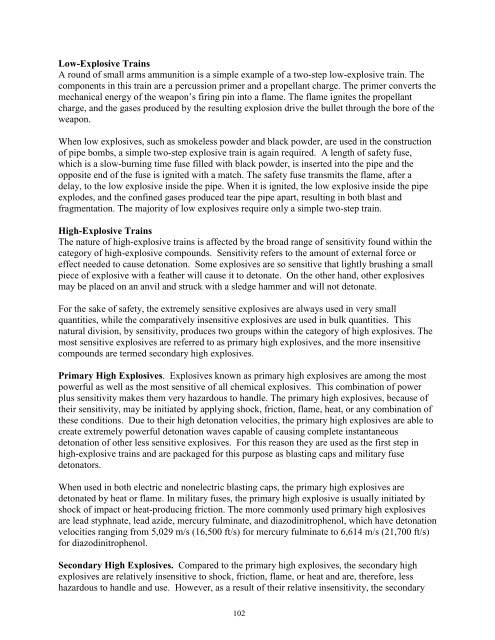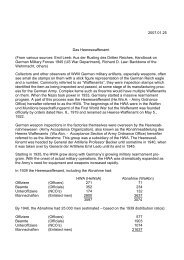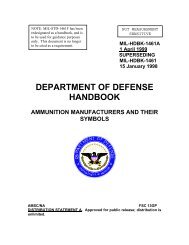Explosives-Nature, Use, Effects and Application.pdf
Explosives-Nature, Use, Effects and Application.pdf
Explosives-Nature, Use, Effects and Application.pdf
Create successful ePaper yourself
Turn your PDF publications into a flip-book with our unique Google optimized e-Paper software.
Low-Explosive Trains<br />
A round of small arms ammunition is a simple example of a two-step low-explosive train. The<br />
components in this train are a percussion primer <strong>and</strong> a propellant charge. The primer converts the<br />
mechanical energy of the weapon’s firing pin into a flame. The flame ignites the propellant<br />
charge, <strong>and</strong> the gases produced by the resulting explosion drive the bullet through the bore of the<br />
weapon.<br />
When low explosives, such as smokeless powder <strong>and</strong> black powder, are used in the construction<br />
of pipe bombs, a simple two-step explosive train is again required. A length of safety fuse,<br />
which is a slow-burning time fuse filled with black powder, is inserted into the pipe <strong>and</strong> the<br />
opposite end of the fuse is ignited with a match. The safety fuse transmits the flame, after a<br />
delay, to the low explosive inside the pipe. When it is ignited, the low explosive inside the pipe<br />
explodes, <strong>and</strong> the confined gases produced tear the pipe apart, resulting in both blast <strong>and</strong><br />
fragmentation. The majority of low explosives require only a simple two-step train.<br />
High-Explosive Trains<br />
The nature of high-explosive trains is affected by the broad range of sensitivity found within the<br />
category of high-explosive compounds. Sensitivity refers to the amount of external force or<br />
effect needed to cause detonation. Some explosives are so sensitive that lightly brushing a small<br />
piece of explosive with a feather will cause it to detonate. On the other h<strong>and</strong>, other explosives<br />
may be placed on an anvil <strong>and</strong> struck with a sledge hammer <strong>and</strong> will not detonate.<br />
For the sake of safety, the extremely sensitive explosives are always used in very small<br />
quantities, while the comparatively insensitive explosives are used in bulk quantities. This<br />
natural division, by sensitivity, produces two groups within the category of high explosives. The<br />
most sensitive explosives are referred to as primary high explosives, <strong>and</strong> the more insensitive<br />
compounds are termed secondary high explosives.<br />
Primary High <strong>Explosives</strong>. <strong>Explosives</strong> known as primary high explosives are among the most<br />
powerful as well as the most sensitive of all chemical explosives. This combination of power<br />
plus sensitivity makes them very hazardous to h<strong>and</strong>le. The primary high explosives, because of<br />
their sensitivity, may be initiated by applying shock, friction, flame, heat, or any combination of<br />
these conditions. Due to their high detonation velocities, the primary high explosives are able to<br />
create extremely powerful detonation waves capable of causing complete instantaneous<br />
detonation of other less sensitive explosives. For this reason they are used as the first step in<br />
high-explosive trains <strong>and</strong> are packaged for this purpose as blasting caps <strong>and</strong> military fuse<br />
detonators.<br />
When used in both electric <strong>and</strong> nonelectric blasting caps, the primary high explosives are<br />
detonated by heat or flame. In military fuses, the primary high explosive is usually initiated by<br />
shock of impact or heat-producing friction. The more commonly used primary high explosives<br />
are lead styphnate, lead azide, mercury fulminate, <strong>and</strong> diazodinitrophenol, which have detonation<br />
velocities ranging from 5,029 m/s (16,500 ft/s) for mercury fulminate to 6,614 m/s (21,700 ft/s)<br />
for diazodinitrophenol.<br />
Secondary High <strong>Explosives</strong>. Compared to the primary high explosives, the secondary high<br />
explosives are relatively insensitive to shock, friction, flame, or heat <strong>and</strong> are, therefore, less<br />
hazardous to h<strong>and</strong>le <strong>and</strong> use. However, as a result of their relative insensitivity, the secondary<br />
102




